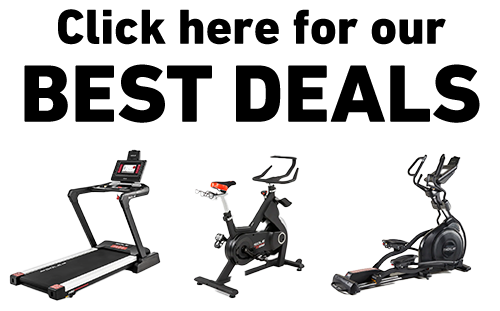Key Takeaways
- Burpees burn approximately 10–15 calories per minute while jump rope burns 10–16 calories per minute, with the exact amount depending on intensity and body weight.
- Jump rope is generally more beginner-friendly and easier on the joints when performed correctly, while burpees provide greater muscle-building benefits.
- Combining both exercises in a single workout routine creates the optimal balance of strength development and cardiovascular conditioning.
- The afterburn effect (EPOC) is significant with both exercises, continuing to burn calories for hours after your workout ends.
- Quality fitness equipment like SOLE Fitness's cardio machines can complement both exercises by providing consistent, low-impact alternatives for recovery days and extended training sessions.
The Calorie-Burning Showdown: Burpees vs Jump Rope
Burpees and jump rope exercises are renowned for their efficiency in torching calories while requiring minimal equipment and space.
The comparison of these two exercises is so fascinating because both exercises deliver remarkable results through completely different movement patterns.
Burpees demand full-body explosive power with multiple position changes, while jump rope relies on rhythmic, consistent cardio output with precise timing.
The question isn't really which is better, it's which one better suits your specific fitness goals, physical capabilities, and personal preferences.
|
Premium Home Gym Equipment with Award-Winning Quality!
Why Choose SOLE: ✓ Commercial-grade quality for home use 30-Day Money-Back Guarantee: Love it or return it, no questions asked. |
Burpees: The Full-Body Calorie Incinerator
The burpee stands as one of fitness's most respected (and sometimes feared) movements for good reason.
The burpee exercise seamlessly blends a squat, plank, push-up, and jump into one fluid motion that challenges virtually every major muscle group in your body.
What makes burpees particularly effective is their ability to simultaneously build strength while dramatically elevating your heart rate, the perfect recipe for maximum calorie expenditure.
The full-body nature of burpees means you're recruiting multiple large muscle groups simultaneously, including your quadriceps, hamstrings, glutes, core, chest, shoulders, and triceps. This comprehensive muscle engagement requires significant energy output, making burpees a metabolic inferno.
How Many Calories Do Burpees Actually Burn?
The caloric expenditure of burpees is truly impressive when compared to traditional exercises. Performing burpees at a moderate to high intensity can burn approximately 10–15 calories per minute.
This rate significantly outperforms conventional strength training exercises and even rivals many forms of cardio. What's particularly valuable about burpees is their scalability across fitness levels. Beginners can modify by removing the push-up or jump components while still achieving substantial calorie burn.
As your fitness improves, you can progress to standard burpees and eventually to more advanced variations that further increase the caloric demand. This adaptability makes burpees an exercise that continues to challenge you regardless of your fitness journey stage.
What Makes Burpees So Effective for Calorie Burning
The secret behind the burpee's calorie-torching power lies in its biomechanical efficiency. By combining multiple movement patterns: a squat thrust, push-up, and explosive jump, burpees create what exercise scientists call "compound-complex" movements.
These exercises demand both horizontal and vertical force production while requiring your body to rapidly transition between ground-based and standing positions. The energy cost of these transitions is substantially higher than maintaining a single position or movement pattern.
Jump Rope: The Cardio King
While burpees command respect in the fitness world, the humble jump rope offers equally impressive calorie-burning potential in a deceptively simple package.
Jumping rope transcends its playground associations to stand as one of the most efficient cardiovascular tools available. Elite boxers, CrossFit athletes, and endurance specialists have long recognized that jump rope training delivers exceptional metabolic demand while improving coordination, rhythm, and athletic footwork.
What separates jump rope from many cardio modalities is its remarkable efficiency-to-effectiveness ratio. The equipment is minimal and portable, the learning curve is manageable, and the space requirements are modest.
Yet despite these modest demands, jumping rope engages your calves, quadriceps, hamstrings, glutes, shoulders, and core simultaneously while requiring precise coordination between your visual, vestibular, and proprioceptive systems.
Jump Rope Calorie Burn: The Numbers Don't Lie
The caloric output from jumping rope impresses even the most seasoned fitness professionals. After 20 minutes of jumping rope, a 200-pound individual can burn anywhere from 240 to 365 calories, depending on their speed.
At higher intensities, incorporating double-unders or weighted ropes, this can increase even more, making it one of the most efficient calorie-burning exercises possible.
What's particularly noteworthy about jump rope calorie expenditure is the relatively lower exertion compared to exercises with similar caloric outputs.
Why Jumping Rope Is a Calorie-Burning Powerhouse
The secret to jump rope's metabolic effectiveness lies in its unique combination of constant movement, gravitational challenges, and coordination requirements.
Each jump requires your body to overcome gravity, generating significant force through your lower body while your upper body maintains constant tension to control the rope. This full-body engagement creates a substantial energy demand that translates to impressive calorie burn.
Jump rope also excels at elevating and maintaining an optimal heart rate for cardiovascular conditioning. The consistent nature of the movement allows exercisers to find their sweet spot, typically between 70–85% of maximum heart rate, and maintain it precisely throughout the workout.
This heart rate zone optimization maximizes caloric expenditure while still allowing sufficient oxygen delivery for sustained effort, creating the ideal environment for both performance improvement and energy utilization.
Direct Comparison: Burpees vs Jump Rope
|
Feature |
Burpees |
Mountain Climbers |
|
Muscle Engagement |
Full-body: legs, glutes, core, chest, shoulders, triceps, calves |
Primarily core, hip flexors, shoulders, and legs |
|
Movement Phases |
Squat, plank, push-up, and jump in rapid succession |
Alternating knee drives in plank position |
|
Calorie Burn |
Extremely high per minute; strong EPOC (afterburn) effect |
High, but generally less than burpees |
|
Cardio Challenge |
Intense, rapid heart rate spikes |
Steady, sustainable cardio at moderate-high heart rate |
|
Power/Explosiveness |
Requires explosive strength for jumps |
Focuses on endurance and sustained dynamic movement |
|
Intensity Level |
Very high; advanced exercise |
Moderate; suitable for most levels |
|
Coordination Required |
High; requires control through multiple movement transitions |
Moderate; easier to learn and maintain form |
|
Best For |
Full-body conditioning, quick calorie incineration, HIIT |
Core strength, aerobic endurance, beginner to advanced |
The Winner Depends on Your Goals
Declaring an absolute winner in the burpees versus jump rope debate oversimplifies the nuanced reality of exercise selection. The optimal choice depends entirely on your specific fitness goals, physical capabilities, and personal preferences.
For those prioritizing functional strength development alongside calorie burn, burpees offer advantages through their multi-joint, multi-planar movement patterns that build power and strength endurance while burning calories.
Individuals focused primarily on cardiovascular endurance and coordination may find jump rope more beneficial. The wisest approach often involves incorporating both exercises into a comprehensive fitness program.
Build Your Complete Calorie-Crushing Fitness Routine With SOLE
At SOLE Fitness, we understand that the burpees versus jump rope debate represents a larger question: how do you create a sustainable, effective home fitness routine that delivers real results? After decades of engineering fitness equipment, we've learned that the most successful fitness journeys combine high-intensity bodyweight movements with reliable, low-impact cardio equipment.
This is where our quality cardio equipment becomes invaluable. Our treadmills, ellipticals, and bikes provide the consistent, measurable progression that bodyweight exercises alone cannot offer. Consider this strategic approach: use burpees and jump rope for your high-intensity interval training 2–3 times per week, then complement these sessions with steady-state cardio on SOLE equipment for active recovery and endurance building.
With SOLE Fitness, you can build a home gym that supports both your explosive training days and your steady-state recovery sessions.
Our SOLE+ app also includes hundreds of free workout classes that seamlessly integrate bodyweight movements with equipment-based training, creating a comprehensive fitness ecosystem in your home. Your fitness journey deserves equipment that matches your commitment. At SOLE, we don't just sell machines; we provide the foundation for lifelong health transformations.
Check out our equipment today!
Frequently Asked Questions (FAQ)
Can I do burpees and jump rope on the same day?
Absolutely! Many fitness enthusiasts combine both exercises in a single workout session. Start with a 5-minute jump rope warm-up, perform burpee intervals for high-intensity strength training, then finish with jump rope for active recovery. This combination maximizes calorie burn while preventing overuse of specific muscle groups.
How long should beginners start with each exercise?
Beginners should start with 30-second intervals for burpees with 60–90 seconds rest between sets, aiming for 3–5 total sets. For jump rope, begin with 1–2 minute continuous sessions, gradually building to 5–10 minutes. Focus on proper form over duration; quality movement patterns prevent injury and improve long-term results.
Which exercise is better for someone with knee problems?
Jump rope is generally more knee-friendly when performed correctly with proper footwear and technique. The key is landing on the balls of your feet with minimal heel contact and maintaining a slight bend in the knees. Burpees involve more dramatic knee flexion and explosive movements that may aggravate existing knee issues.
How do these exercises compare to running on a treadmill for calorie burn?
Both burpees and jump rope actually burn more calories per minute than moderate-pace treadmill running. While treadmill running at 6 mph burns approximately 8–10 calories per minute, burpees and jump rope both exceed 10+ calories per minute. However, treadmill workouts can typically be sustained much longer, potentially resulting in higher total session calorie expenditure for endurance-focused individuals.
Do I need any equipment besides a jump rope for these workouts?
While both exercises can be performed with minimal equipment, having quality cardio machines can enhance your overall fitness routine. SOLE Fitness’s treadmills and ellipticals provide excellent low-impact alternatives for active recovery days, helping you maintain cardiovascular fitness while allowing high-impact joints to recover between burpee and jump rope sessions.







Leave a comment
This site is protected by hCaptcha and the hCaptcha Privacy Policy and Terms of Service apply.